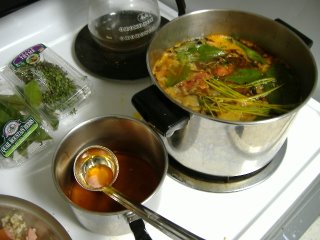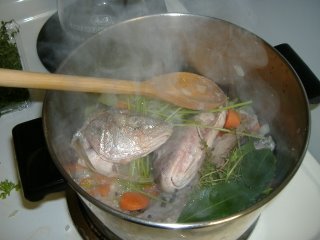


Top: Brown beef stock at right, pure clarified beef fat in saucepan at left. Off-screen is my breakfast.
Middle: Bones beginning to caramelize.
Bottom: Fumet, or fish stock.
Why am I making multiple kinds of stocks? I have no idea. Just to have them handy, I guess. They are called stocks.
I feel like typing for awhile:
TO MAKE BROWN STOCK:
The official recipe to yield a gallon is 5-6 lbs bones, 1 lb mirepoix (chopped vegetables consisting of 50% onion, 25% carrot, 25% celery), 8 oz tomato product, 5-6 quarts water, and a sachet d`espice--thyme, bay leaf, peppercorn, parsley stems. That's traditionally tied into a cheesecloth bag and draped over the side of the stockpot, but since we have better strainers than Escoffier did, it doesn't really matter anymore. Whole cloves are sometimes added to this in very small quantities, and my book says garlic is optional, but I would never put garlic into a stock.
Put the bones into a roasting pan and crank your oven up. It'll take awhile to begin, but after maybe 15 minutes the bones will start to caramelize. You'll smell and see the difference--the white will turn to a nice mahogany, the aroma will be richer, etc. Be sure to turn the bones occasionally. When they're halfway there, add the mirepoix. It helps to toss the vegetables in the fat that has rendered out of the bones before putting the pan back into the oven. Eventually your bones and veggies will be about the same color. Have your tomato paste ready for this, and a pastry brush. Coat the bones and vegetables with the tomato paste, making sure to do so EVENLY or you will have tomato soup rather than pincage (name for caramelized tomato product). Put the pan back in, and let the tomato paste brown like all the other stuff. You're done with the brown part of the stock, so dump all your stuff into a big pot and cover it with water. There will be a lot of stuff stuck to the roasting pan--grease, pieces of meat, etc. We want to conserve that flavor, so put the pan atop a range, get it nice and hot, and deglaze with a glass of cold water. The water skittering across the surface of the pan will help to release that fond (French word for shit stuck to the pan, meaning, roughly, foundation). Dump all that goodie into your pot as well.
Throw the sachet in, and bring to a simmer, NOT A BOIL, and slowly. Never, ever, ever, ever boil stocks. Never. If you need them to be done faster, give up and go buy some Minor's Beef Base. Also, never stir your stocks. The reason for this is that we must continuously skim the junk off the top of them, a process called depouillage. You'll see foam, rendered fat, scum, etc, which can be any number of things including coagulated blood. A lot of chefs rinse or blanch their bones before making stock to help reduce the amount of this junk, but I think you lose a lot of flavor that way. Anyway, it's stuff that we can't strain out and we don't want to eat. Get a cup of water and a ladle, and start skimming--using the entire ladle to take out all the fat on top the first few hours, and then the back of the ladle for foam and other junk. Make sure that if you are using the entire ladle for anything that you're just getting fat and not stock--you don't want to waste anything.
Save the fat. Keep a saucepan close to dump the ladled fat in and keep it on a very low heat in order to clarify it--you have to let all the water evaporate out of it (be careful, it'll pop towards the end), and once that's done, it can be strained through a coffee filter. Why would you save all this saturated animal fat? To cook with. Trust me. Forget all you have learned about nutrition and the fucking South Beach Diet and sautè something in the purified fat of a steer and you will live like you have never lived before.
The stock is going to simmer for six to eight hours. You don't have to be there the entire time, of course, but be sure to check on it, make sure it's at a simmer, not a boil, skim it, add more cold water if it reduces too much and the bones are no longer covered. When it's done, strain it. Not through one of those plastic colanders you use for your fettucine, but through something fine. Ideally, you would use a chinois, which is a cone-shaped device lined with very fine steel mesh. Since most people don't want to spend the 90+ dollars it takes to acquire one of those, you're better off just using a metal coffee filter--it's essentially the same thing, though smaller and more of a pain in the ass.
Cool the stock off. If it begins to turn into a big, beef-flavored jello mold in the refridgerator, you've done a very nice job. The gelatin present in the bones is extracted into the stock and firms up when cooled, and is a sign of a rich stock. Use it for stuff. It beats the hell out of bouillon cubes.
No comments:
Post a Comment